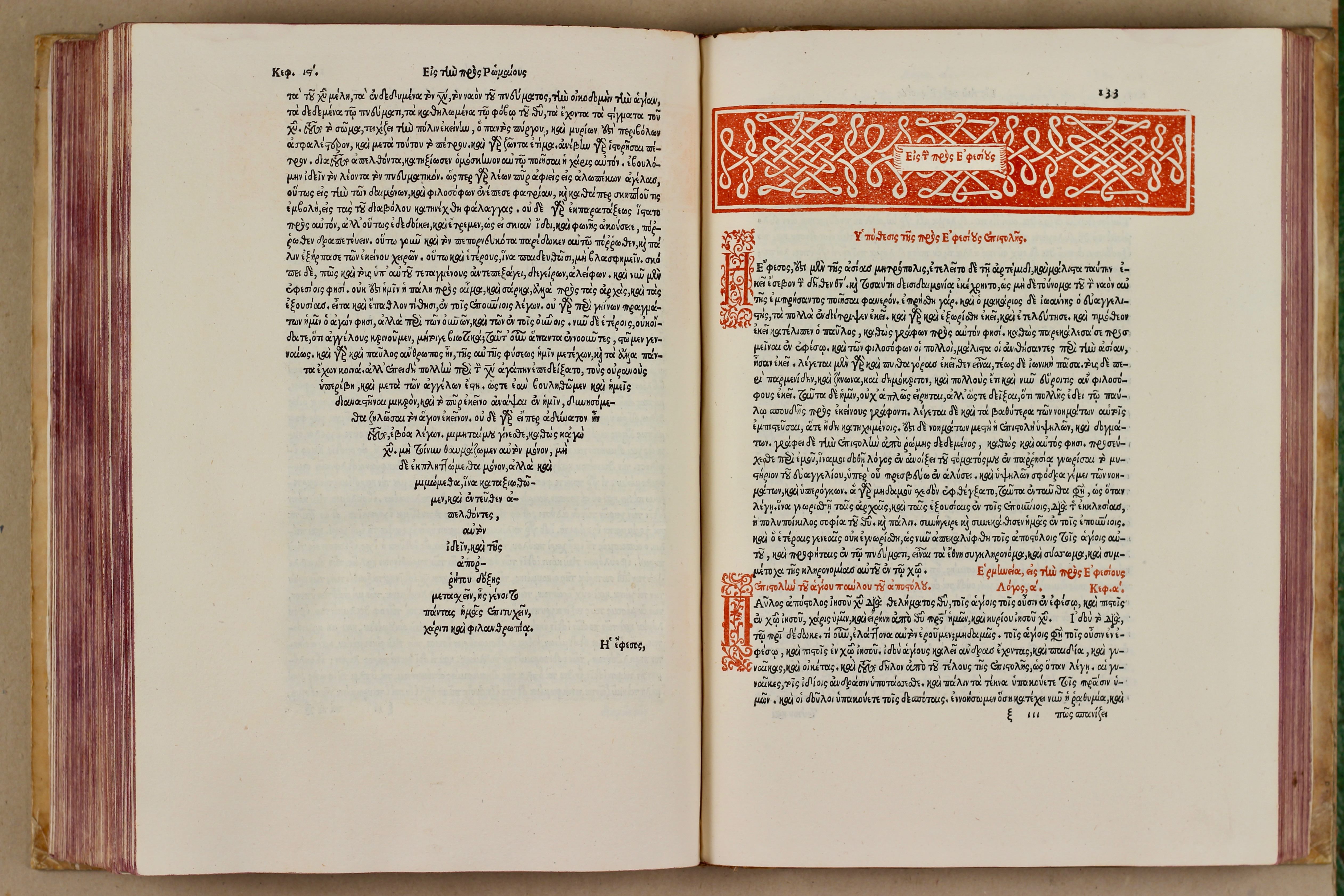Johannes Chrysostomos
Εἰς τοῦ Παύλου ἐπιστολὰς […] — Verona 1529
12.000 €Τοῦ ἁγίου Ἰοάννου τοῦ Χρυσοςτόμου Εἰς πάσας τοῦ Παύλου τοῦ ἀπόστολου ἐπιστολὰς ἀκριβεστάτη, καὶ χρασῆ ἀλεθῆς, καὶ θεία ἑρμηνεία. Divi Ioannis Chrysostomi In omnes Pauli apostoli epistolas accuratissima, vereque aurea, & divina interpretatio. 4 volumes in 3. — Verona, per Stephanum & fratres a Sabio, quarto kalendas Iulias [i. e. June 28] 1529.
Editio princeps
Folio (346 x 246 mm). Printed in Greek.
Volume I: ✠ 10 α-υ10 φ4, blank α10 present: (10), 204 leaves.
Volume II:αα-ωω10 Αα, Ββ8, blank Ββ8 present: 255 leaves,(1) blank leaf.
Volume III: Α-Ω ΑΑ10, blank ΑΑ10 present: 249 leaves, 1 blank leaf.
Volume IV: ΑΑΑ-ΛΛΛ10, blanks ΛΛΛ9, 10 present: 107 leaves, (1) leaf colophon, (2) blank leaves.
Red printing on leaves: I. 1, 3, 133. II. 1, 34, 48. III. 1, 93, 109, 205. IV. 1, 42, 71, 78.
Watermark: Anchor in circle with cross at its top, 60 mm high, 44 mm wide) and FB, the F open to the left. Not in Briquet.
Page numbers misprinted, correct numbers following slash: I. 151/142, 154/153. II. 521/215, 251/249. III. 109/110, 136/161, 206/176, 195/185, 200/210, 214/217. IV. 214/48, 64/67, 74/73, 102/104.
Faint waterstaining to outer margin of the first two quires in volume III.
Provenance: Old stamp in black in the lower margin of a number of leaves: Loci Cappucinorum Veronae.
Late 16th century vellum over stiff boards. Manuscript title on spine. Spine of volume 3 rebacked, original spine laid down.
Following Dibdin, Voyage bibliographique, II, 99, „this edition is the most beautiful of all printed by the Sabio brothers“ (quoted from Hoffmann, Bibl. Lexicon, II, 405); likewise Graesse II, 152: „la plus jolie production des presses des Sabio“. Adams C 1539.
A beautifull, fresh and wide-margined copy of a masterpiece of Greek printing.
¶ „The brothers Nicolini da Sabbio or Sabio were the most active printers of Greek in Italy during the second quarter of the sixteenth century.“ They worked in Venice, Rome, Milan, Ferrara, Brescia, Bergamo, and from 1529 to 1532 in Verona.
„Stefano was the dominant and most accomplished member of the brothers Nicolini da Sabbio.“ After leaving Venice in 1528 „we next find Stefano and at least one of his brothers in Verona, called there by Gian Matteo Giberti (1495-1543), Bishop of Verona, who wished to publish a series of patristic texts. A printing press was established in the episcopal palace next to the cathedral, and the Nicolini da Sabbio were lodged near their work. Although there is only brief mention of the new Greek and Latin types cut for the Giberti press …, we can safely deduce that they were engraved and cut by Stefano with the assistance of his brother …
Some time toward the end of 1532, Stefano and his brother returned to printing in Venice … No one seems to know why the Verona press ceased its operations so abruptly …
The Nicolini da Sabbio printed their Greek books with a variety of Greek fonts, five in Venice alone, two in Verona, one in Rome …“ The first of the Verona fonts is a boldface cursive used in the Chrysostomos and in Joannes Damascenus’ Ἔκδοσις τῆς Ὀρθοδόξον πίστεως, the second one of nearly similar size was used in Oecumenius, Ἐξηγήσεις παλαιαί. (Quotations are from Layton, The sixteenth century Greek Book in Italy, pp. 402ff.)
See also Pino Simoni, Stefano Nicolini e fratelli tipografia Verona nel Cinquecento, in: Civiltà veronese, 1988, pp. 23-40, and E. Layton, Andreas Kounadis and the Nicolini da Sabbio, in: The Printed Greek Book. 15th – 19th century. Acts of the international congress Deplhi, 16-20 May 2001, Athens 2004, pp. 69-79.
Editor of the Chrysostomos was Bernardino Donato, il celebre letterato from Verona (ca. 1470-1532), who held the chair of Greek in Padua from 1526 onwards, then lectured in Verona, published a book on the differences of the philosophies of Plato and Aristotle, edited besides the Chrysostomos the books mentioned above, and a few more. He was direttore editoriale of the Giberti press. The Chrysostomos was dedicated by Donato to Clemens VII, i. e. Guilio de’ Medici.

